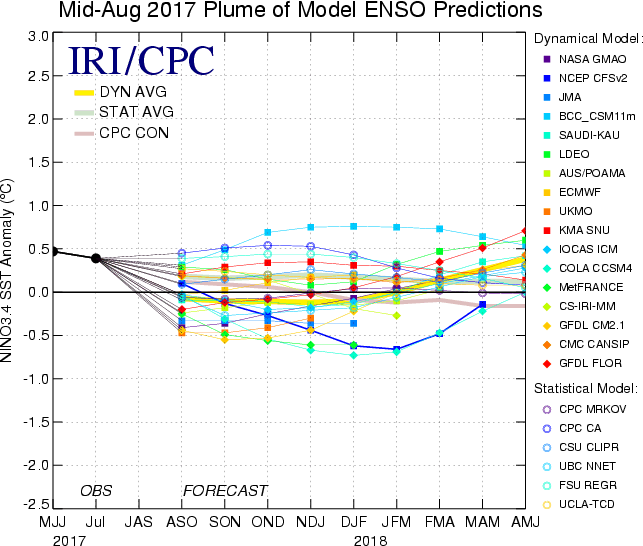
but the fact the diagnostic discussion is making a point of the watch means we're going to pay attention to possible development.
From the CPC:
| 14 September 2017 |
|
ENSO Alert System Status:
La Niña Watch
|
|
Synopsis: There is an increasing chance (~55-60%) of La Niña during the Northern Hemisphere fall and winter 2017-18.
Over the last month, equatorial sea surface temperatures (SSTs) were
near-to-below average across the central and eastern Pacific Ocean [Fig. 1]. ENSO-neutral conditions were apparent in the weekly fluctuation of Niño-3.4 SST index values between -0.1°C and -0.6°C [Fig. 2]. While temperature anomalies were variable at the surface, they became increasingly negative in the sub-surface ocean [Fig. 3], due to the shoaling of the thermocline across the east-central and eastern Pacific [Fig. 4].
Though remaining mostly north of the equator, convection was
suppressed over the western and central Pacific Ocean and slightly
enhanced near Indonesia [Fig. 5].
The low-level trade winds were stronger than average over a small
region of the far western tropical Pacific Ocean, and upper-level winds
were anomalously easterly over a small area of the east-central Pacific.
Overall, the ocean and atmosphere system remains consistent with
ENSO-neutral. A majority of the models in the IRI/CPC suite of Niño-3.4 predictions favor ENSO-neutral through the Northern Hemisphere 2017-18 winter [Fig. 6]. However, the most recent predictions from the NCEP Climate Forecast System (CFSv2) and the North American Multi-Model Ensemble (NMME) indicate the formation of La Niña as soon as the Northern Hemisphere fall 2017 [Fig. 7]. Forecasters favor these predictions in part because of the recent cooling of surface and sub-surface temperature anomalies, and also because of the higher degree of forecast skill at this time of year. In summary, there is an increasing chance (~55-60%) of La Niña during the Northern Hemisphere fall and winter 2017-18 (click CPC/IRI consensus forecast for the chance of each outcome for each 3-month period).... MORE |